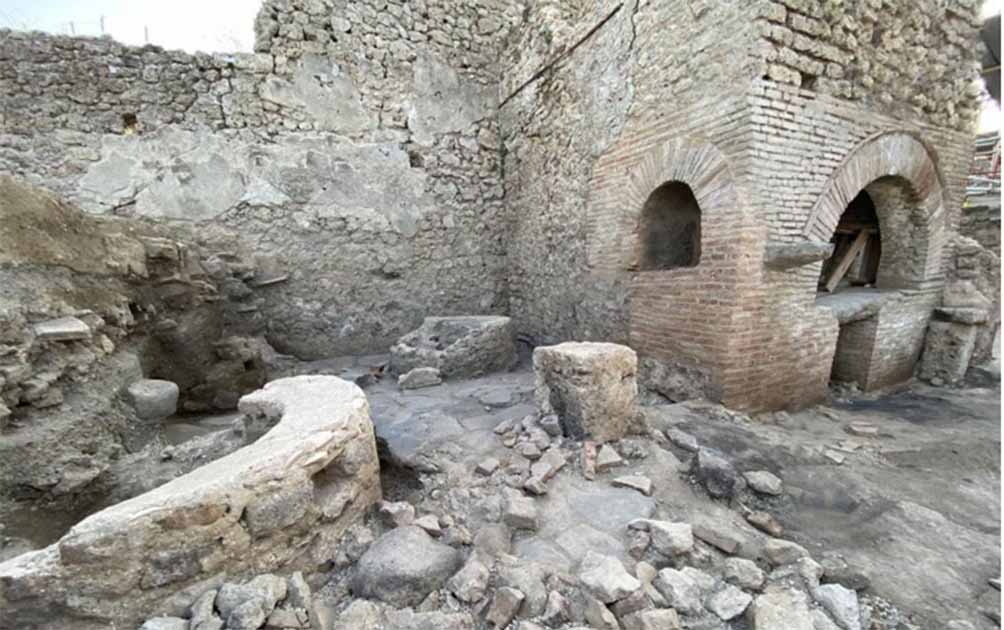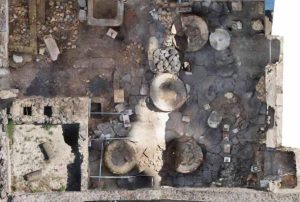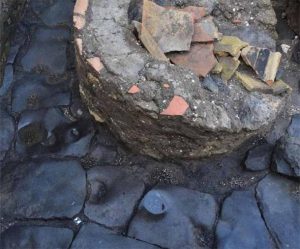Found in Pompeii, a brutal bakery-prison run by slaves and donkeys

Archaeologists searching through excavated rubble at the site where Pompeii once stood in southern Italy recently discovered the remains of a small, cramped room with unique characteristics and a singular design. Found inside the walls of an elite dwelling in ancient Rome’s most famous doomed city, this room has now been identified as a home bakery, which featured an elaborate grain milling and flour collecting system.
In an article just published by the official E-Journal of the Pompeii Archaeological Park, the discoverers accurately describe this claustrophobic facility as “a bakery-prison, where enslaved workers and donkeys were confined and exploited to grind the grain needed to make bread.”
Inside the Horrific Bakery-Prison
The bakery hardly resembled a modern bread-making facility. It was enclosed within the interior of a large residential building, with no outside facing walls. There were small windows added to the room’s exterior, but they were covered with iron grates and only allowed a limited amount of light to penetrate the gloomy space.

Pompeii: The Ancient Roman City Frozen in Time
Lavish Home of Two Former Slaves Opened Up to the Public in Pompeii
The site of the bakery prison in Pompeii seen from above. (Pompeii archaeological park)
There were several millstones in the room’s center, which were used to grind the grain that was converted into flour. This activity was carried out primarily by pack animals (likely donkeys) that were trapped inside the room and forced to pull the millstones for hours on end each day, and they performed this work blindfolded to prevent them from panicking or trying to escape.
One of the bakery’s most notable architectural features consists of a series of shallow circular-shaped trenches carved into the basalt rock floor, which reveals how the animals were controlled. The donkeys would have been confined to these trenches, as they walked endlessly in circles turning the millstones. The only door in the room led directly to an atrium, which then opened into a barn or stable where the animals would have been housed when they were not working.
This cramped room would have been shared by animals and human slaves at all times. The latter would have been supervising the donkeys, collecting the flour, and adding fresh grain to the milling system to keep it going without pause.
Exposing the Brutal Realities of Slavery in the Roman Empire
The ancient ruined bakery, which was still presumably in use when the eruption of Mount Vesuvius buried Pompeii in a mountain of ash and lava in 79 AD, reveals the extreme cruelty for which the Roman Empire was known.
This was “a space in which we have to imagine the presence of people of servile status whose freedom of movement the owner felt the need to restrict,” stated Pompeii Archaeological Park director Gabriel Zuchtriegel in the E-Journal article. “It is the most shocking side of ancient slavery, the one devoid of trusting relationships and promises of tampering, where one was reduced to brute violence, an impression that is fully confirmed by the closing of the few windows with iron grates.”
The bakery was located in the working quarters of a sprawling house occupied by a wealthy Roman family, who would have lived a life of relative ease and comfort as a result of their exploitation of slaves and animals. As such they were the perfect representation of the social, cultural and economic realities of the Roman Empire in the first century AD, which relied heavily on enslaved people to perform all the hard work so that elites would have more time to indulge their fancies and fantasies.
In Pompeii slaves comprised about 30 percent of the city’s total population of 12,000 people just before the settlement was destroyed. This testifies to the level of human trafficking and bondage that were necessary to maintain the luxurious lifestyles preferred by Roman aristocrats who lived during Roman Empire times.
There is little doubt that the newly discovered bakery was built to the same specifications as other bread-making facilities in Pompeii, and elsewhere in Roman lands. The grueling activity required to turn grain into flour was reserved for slaves and animals, and more merciful working conditions would not have been provided anywhere.

The bakery prison reveals the extreme cruelty for which the Roman Empire was known. (Pompeii archaeological park)
The presumption that donkeys were used as mill-grinding animals is based partially on the writings of a second century Roman historian and author named Apuleius, who witnessed the bread-making process and left behind an account of how this activity was organized. The donkeys were kept blindfolded while traversing their “circular furrows,” Apuleius wrote, accompanied by and assisted by slaves at all times. His claims were supported by other writers who knew how the bread-making system operated, and by Roman rock carvers who created images depicting the process in action.
“Iconographic and literary sources, particularly the reliefs from the tomb of Eurysaces in Rome, suggest that a millstone was usually moved by a couple consisting of a donkey and a slave,” Gabriel Zuchtriegel explained. “ The latter, in addition to pushing the grindstone, had the task of inciting the animal and monitoring the grinding process, adding grain, and collecting the flour.”
Horrific Slave Room Discovered in Pompeii’s Civita Giuliana
Mummified Remains Of A Former Slave Discovered At Pompeii
With the discovery of the bakery inside the ancient home in Pompeii, archaeologists now have direct physical confirmation of what the historical records suggest took place.
Nature’s Fury, the Great Social Equalizer
Based on the results of the complete excavation of the ancient Roman residence, it seems the home was undergoing renovations when it was buried under the ashes and molten rock that inundated Pompeii in 79 AD. The skeletal remains of three victims of this catastrophe were actually found inside the room that has now been identified as a bakery, although there is no way to tell if these were slaves who frequented this space or household residents seeking a safe place to escape the lava flow.
Ultimately the violent eruption of Mount Vesuvius terminated the lives of Pompeii residents of all classes and statuses with equal suddenness, revealing human vulnerability to acts of nature that no amount of prosperity, luxury or exploitation of others can counteract.